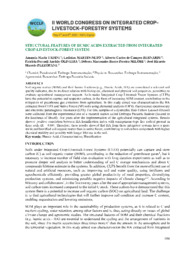Structural features of humic acids extracted from integrated crop-livestock-forest system.
Structural features of humic acids extracted from integrated crop-livestock-forest system.
Author(s): TADINI, A. M.; MARTIN NETO, L.; BERNARDI, A. C. de C.; OLIVEIRA, P. P. A.; MILORI, D. M. B. P.; PEZZOPANE, J. R. M.
Summary: Soil organic matter (SOM) and their humic fractions (e.g., Humic Acids, HA) are considered a relevant soil quality indicator, due to its direct relation with biological, chemical and physical soil properties, permitting to evaluate agricultural management impacts. Soils under Integrated Crop-Livestock-Forest Systems (CLFS) have the potential to capture and sequester carbon, in the form of increasing SOM content, contributing to the mitigation of greenhouse gas emissions from agriculture. In this study aimed was characterization the HA extracted from CLFS and Native Forest (NF) soils using elemental analysis (CHN), fluorescence spectroscopy and electronic paramagnetic resonance (EPR). For this, samples of a dystrophic Red-Yellow Latosol (Oxisol) were collected from the experimental site of a research station called Embrapa Pecuária Sudeste (located in the Southeast of Brazil), five years after the implementation of the agricultural integrated systems. Results showed positive correlation between HA humification index with semiquinone-type free radical present in these soils (R = 0.69). Therefore, these results showed that HA from these integrated systems have a more stable and humified soil organic matter than in native forest, contributing to soil carbon compounds with higher chemical stability and possibly with longer lifetime in the soil.
Publication year: 2021
Types of publication: Paper in annals and proceedings
Unit: Embrapa Instrumentation
Keywords: Characterization, Humic Acid, Humification, ILPF
Observation
Some of Embrapa's publications are published as ePub files. To read them, use or download one of the following free software options to your computer or mobile device. Android: Google Play Books; IOS: iBooks; Windows and Linux: Calibre.
Access other publications
Access the Agricultural Research Database (BDPA) to consult Embrapa's full library collection and records.
Visit Embrapa Bookstore to purchase books and other publications sold by Embrapa.

